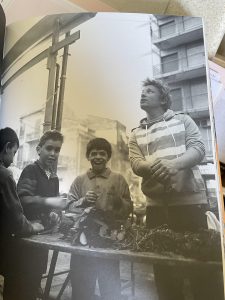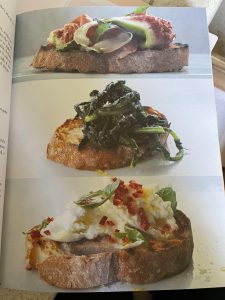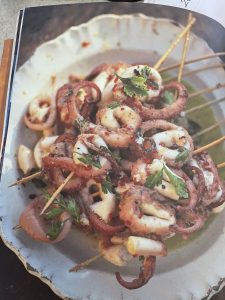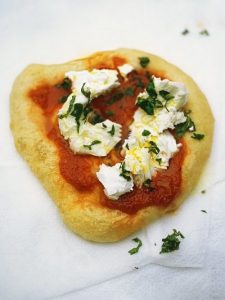Una Storia del Cibo Italiano: An Analysis of Jamie Oliver’s, Jamie’s Italy
What is Jamie’s Italy? Who is Jamie Oliver?
Jamie’s Italy is a specialty cookbook written by celebrity chef, Jamie Oliver, that focuses on the Italian culture and cuisine. Jamie Oliver is a British celebrity chef who credits his fame to writing many successful cookbooks, including The Naked Chef, Jamie’s Kitchen, Jamie’s Dinners, and many more. He is known for promoting healthy meals for young students in schools, and has even founded an organization called the Fifteen Foundation, which helps financially struggling teenagers learn how to cook for themselves (Schreiber, 2008). He was brought into the cooking profession by his parents, who owned a successful restaurant when he was young. He began working there when he was just eight years old, and remained in the restaurant business for years to come (Schreiber, 2008). In addition to promoting healthier diets for students, Oliver has also spent a significant part of his career studying Italian cuisine and traveling to Italy to ultimately share his lessons with others in this cookbook as well as in his restaurants (Schreiber, 2008).

Jamie’s Italy was published in 2006, but the recipes within the book are not at all related to the time period in which it was written. Rather, the book focuses on traditional recipes in Italy that span over generations of food culture. As a result, when the reader skims through these recipes, he or she is also skimming through years of Italian history and tradition through food. Often, the recipes included in this book are claimed by a certain town or region of Italy where it originated, for example, the rice tart from Florence (Oliver, 2006, p. 284) has been a tradition in Florence for years, so the reader is able to become a part of this tradition and feel immersed in the Italian way of life. The book includes several dishes that are undoubtedly Italian by nature, technique and taste. A few examples of this are the Italian style

fish with crispy batter (Oliver, 2006, p. 42), Oliver’s famous Italian roast pork (Oliver, 2006, p. 48), many pasta dishes that originate from specific people’s recipes like Norma’s pasta (Oliver, 2006, p. 88) and Grandad’s mussel linguine (Oliver, 2006, p. 93), and lastly, pages upon pages of pizza (Oliver, 2006, p. 49-59). The introduction section of the cookbook provides specific details on what the reader should expect from this book- a glimpse into authentic Italian cuisine as experienced by Oliver during his trip to this fascinating country. Oliver’s intent for this cookbook was not to overwhelm the reader with as many complex dishes and recipes as possible, but to simplify the Italian cuisine so the reader could understand the recipes, as well as be able to make the dishes unique to themselves (Oliver, 2006, p. xi).
Who is Jamie’s Italy tailored towards?
The recipes in Jamie’s Italy themselves are generally simplistic and Oliver uses little structure in these recipes as a way to give the reader freedom to make the dish special to them. This is seen in the book through the loose forms of measurement that he suggests, including “two handfuls of nice mixed ripe tomatoes, a small bunch of fresh basil, sea salt and freshly ground black pepper, olive oil, good quality white wine and herb vinegar” for tomato and basil bruschetta (Oliver, 2006, p. 7). Clearly, these forms of measurement are quite vague and the specification of what “good quality white wine” should be is not included, so Oliver provides room for interpretation. While this simplicity can be used to give readers an interpretive view of these recipes, Oliver’s use of loose measurements and lack of detail in steps to cooking in the recipes could also mean he is trying to reach an audience with some prior knowledge of cooking techniques. In a recipe for sushi del chianti, Oliver mentions that the “beef should not have any sinew on it at all, but if it has, remove them with a knife and slice and finely chop the meat” (Oliver, 2006, p. 15). As an amateur cook, a reader may have trouble understanding these instructions and knowing what a sinew is and how

to remove it from a piece of meat.
There is a paradoxical relationship, therefore, between Oliver’s intent for the book and the delivery of it. More specifically, Oliver intends for this book to be simple, with straight to the point dishes that people could even take their own spin on to make them original to them. However, a lot of the dishes end up being quite complex and inaccessible for many people because of the ingredients and techniques used. Oliver assumes that the readers of this book have much wider access to ingredients than what reality allows. For example, not everyone will have ready access to a whole pig or multiple whole fish (Oliver, 2006, p. 200), or even freshly grated Parmesan cheese (Oliver, 2006, p. 44). While the book does not target any particular gender, family status, race or ethnicity, education or identity, it certainly targets people who have background knowledge of cooking techniques, wider access to ingredients, and higher socioeconomic status. In other words, this book would not be useful for those who struggle financially because although the recipes themselves are simple, the ingredients, utensils and techniques needed to prepare these dishes are not typically available to people with lower socioeconomic status.

The Intricacy of Italian Foodways & Authenticity
The book emphasizes the individuality of Italian cuisine, and how there really is no universally Italian way of cooking. Yes, Americans have an idea of what is Italian and what is not, but Italians often disagree on what foods they consider to be “truly Italian.” One part of the book stated that “Every village in Italy has its own way of shaping pasta. On the Ligurian coast, they call the shapes “silk handkerchiefs” because they’re light and delicate” (Oliver, 2006, p. 110). The book does not go into much detail of lack of national food identity, but this example of each village having its own pasta shape certainly alludes to it.
This disagreement among Italians is a prime of example of complexity within foodways. Italian foodways are extremely unique, in that they are so individualized and local that certain food customs in one town may never be heard of in the neighboring town. This is shown in the many recipes that are labeled are strictly Tuscan, strictly Ligurian, etc. (Oliver, 2006, p. 110). Despite the disagreement, Italian Campanilismo, which refers to the love, pride and attachment Italians have to their local food traditions, is still celebrated throughout the country. Campanilismo is a perfect representation of why Italians keep their foodways so individualized- they are so proud of their own dishes that they refuse to accept any others as “truly Italian.” Campanilismo allows Italians to have pride in the food they have been making and eating since they were children, since their parents were children, and so on. Only those customs exist in their household, town or city, and that sense of pride is extremely strong. The Italians take hours and hours to harvest and prepare food for their meals, for example, the olive pickers who are paid in large amounts of olive oil instead of money (Oliver, 2006, p. xv).

A major concept that radiates through Oliver’s book is authenticity. Both types of authenticity, otherizing and traditionalizing are incorporated. Otherizing, which refers to making an experience more authentic in a foreign way, so in this case, “authentically Italian,” is seen through Oliver’s use of Italian language throughout the book when he titles all the recipes in Italian. He also includes classic Italian dishes that many Americans know and love, such as bruschetta, pasta, pizza, and more. Traditionalizing, however, is even more prominent, so much so that one would need a background understanding of Italy’s culture and lifestyle to be able to really take away from this cookbook. Tradition in Italy is as important as money is in America. Oliver traditionalizes this cookbook by incorporating many pictures of him with Italian farmers, shepherds and chefs who he learned many of his techniques from as to emphasize the connection of these foods to the Italy way of life (Oliver, 2006, p. 16, 100, 104, 108, 128, 237, 258). Through the emphasis of authenticity in this cookbook, the reader is exposed to a wide variety of Italian dishes, their historical backgrounds, and the lifestyle assumed by people who eat these foods most often. Although the book is not widely useful for a general population, Oliver still manages to exemplify the Italian cuisine and culture in a simple way that can be understood and reflected upon by many.
References
Oliver, Jamie. (2006). Jamie’s Italy. New York: The Penguin Group.
Schreiber, Barbara A. (Jan 4, 2008). Jamie Oliver: British Chef. Retrieved from
https://www.britannica.com/biography/Jamie-Oliver.